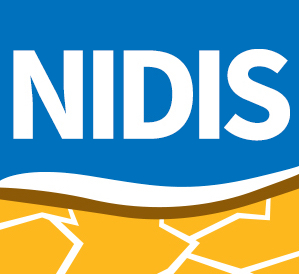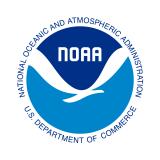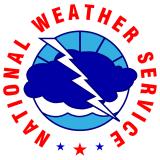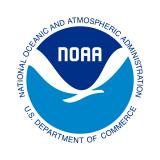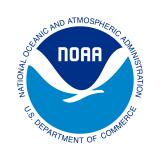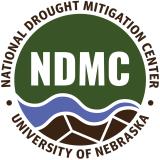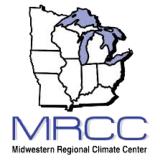Minimal Drought Across the Midwest. July Outlook Forecasts Above-Normal Temperatures for Upper Midwest.
Key Points
- Drought is minimal across the Midwest, with only 6% of the region in Moderate to Severe Drought (D1-D2), according to the U.S. Drought Monitor. However, 23% of the region is Abnormally Dry (D0). An isolated area of Severe Drought (D2) has persisted in central Michigan since mid-November 2024.
- Below-normal precipitation over the last two months caused drought conditions to develop or persist across portions of northern Illinois, northwest Indiana, southern Iowa, and northern Missouri.
- Drought impacts include below-normal streamflow and soil moisture in some areas. Overall, crops and pastures remain in good to excellent condition, according to the U.S. Department of Agriculture. Dry, hot, and windy conditions in Minnesota and Wisconsin during May and June contributed to more wildfires than normal.
- The monthly outlooks for July 2025 show potential for above-normal temperatures across the Upper Midwest. The precipitation outlook is mixed, with a greater likelihood of below-normal precipitation in far western Iowa and Minnesota, above-normal precipitation in eastern portions of the region, and equal chances of above-, near-, and below-normal precipitation elsewhere.
- For portions of the Upper Midwest already in drought, conditions may persist or worsen for areas that receive above-normal temperatures and below-normal precipitation in July.
- For areas where drought persists or develops, potential impacts include inadequate moisture for crop growth, elevated risk for wildfire, and hydrological issues like low streamflow, lakes, and ponds.
This update is based on data available as of Thursday, June 26, 2025 at 8 a.m. CT. We acknowledge that conditions are evolving.
The U.S. Drought Monitor depicts the location and intensity of drought across the country. The map uses 5 classifications: Abnormally Dry (D0), showing areas that may be going into or are coming out of drought, and four levels of drought (D1–D4).
The U.S. Drought Monitor is a joint effort of the National Oceanic and Atmospheric Administration, U.S. Department of Agriculture, and National Drought Mitigation Center.
A drought index combines multiple drought indicators (e.g., precipitation, temperature, soil moisture) to depict drought conditions. For some products, like the U.S. Drought Monitor, authors combine their analysis of drought indicators with input from local observers. Other drought indices, like the Standardized Precipitation Index (SPI), use an objective calculation to describe the severity, location, timing, and/or duration of drought.
Learn MorePeriods of drought can lead to inadequate water supply, threatening the health, safety, and welfare of communities. Streamflow, groundwater, reservoir, and snowpack data are key to monitoring and forecasting water supply.
Learn MoreDrought can reduce the water availability and water quality necessary for productive farms, ranches, and grazing lands, resulting in significant negative direct and indirect economic impacts to the agricultural sector. Monitoring agricultural drought typically focuses on examining levels of precipitation, evaporative demand, soil moisture, and surface/groundwater quantity and quality.
Learn MoreU.S. Drought Monitor Categories
D0 - Abnormally Dry
Abnormally Dry (D0) indicates a region that is going into or coming out of drought. View typical impacts by state.
D1 - Moderate Drought
Moderate Drought (D1) is the first of four drought categories (D1–D4), according to the U.S. Drought Monitor. View typical impacts by state.
D2 - Severe Drought
Severe Drought (D2) is the second of four drought categories (D1–D4), according to the U.S. Drought Monitor. View typical impacts by state.
D3 - Extreme Drought
Extreme Drought (D3) is the third of four drought categories (D1–D4), according to the U.S. Drought Monitor. View typical impacts by state.
D4 - Exceptional Drought
Exceptional Drought (D4) is the most intense drought category, according to the U.S. Drought Monitor. View typical impacts by state.
Total Area in Drought (D1–D4)
Percent area of the Midwest that is currently in drought (D1–D4), according to the U.S. Drought Monitor.
The U.S. Drought Monitor depicts the location and intensity of drought across the country. The map uses 5 classifications: Abnormally Dry (D0), showing areas that may be going into or are coming out of drought, and four levels of drought (D1–D4).
The U.S. Drought Monitor is a joint effort of the National Oceanic and Atmospheric Administration, U.S. Department of Agriculture, and National Drought Mitigation Center.
The U.S. Drought Monitor is released every Thursday morning, with data valid through the previous Tuesday at 7 a.m. ET.
A drought index combines multiple drought indicators (e.g., precipitation, temperature, soil moisture) to depict drought conditions. For some products, like the U.S. Drought Monitor, authors combine their analysis of drought indicators with input from local observers. Other drought indices, like the Standardized Precipitation Index (SPI), use an objective calculation to describe the severity, location, timing, and/or duration of drought.
Learn MorePeriods of drought can lead to inadequate water supply, threatening the health, safety, and welfare of communities. Streamflow, groundwater, reservoir, and snowpack data are key to monitoring and forecasting water supply.
Learn MoreDrought can reduce the water availability and water quality necessary for productive farms, ranches, and grazing lands, resulting in significant negative direct and indirect economic impacts to the agricultural sector. Monitoring agricultural drought typically focuses on examining levels of precipitation, evaporative demand, soil moisture, and surface/groundwater quantity and quality.
Learn MoreCurrent Conditions and Impacts for the Midwest
- Drought conditions improved across the Upper Midwest over the last two months, with only 6% of the Midwest in Moderate to Severe Drought (D1-D2), according to the U.S. Drought Monitor. 27% less of the region is in drought compared to three months ago.
- While the lower half of the region is free of drought or Abnormal Dryness (D0), there are some pockets in the northern half of the region where drought persists and conditions developed or worsened over the last two months. The areas where drought worsened include northern Illinois, northwest Indiana, southern Iowa, and northern Missouri.
- Other areas with persistent drought include central Michigan, where an isolated area of Severe Drought (D2) has persisted since mid-November 2024, northern Minnesota, and northwest Iowa.
- Precipitation has been below normal for a large portion of the Midwest since April 24, including Iowa, Illinois, northern Missouri, Wisconsin, and Michigan. Much of the Ohio River Basin continued to receive above-normal precipitation.
- Extreme heat this past week contributed to drought persistence across the region. Many locations reached temperatures of 90°F or above for multiple days.
- Streamflow is normal to above-normal in southern portions of the Midwest, and soil moisture is near-normal in many areas. There are pockets of below-normal streamflow and soil moisture in northern Missouri, southern Iowa, northern Illinois, northern Minnesota, and Michigan.
- The Upper Midwest has already seen significant wildfire this year.
- In northeast Minnesota, two large fires ignited on May 12-13 and burned for weeks before full containment was achieved. These fires burned over 30,000 acres of land in Minnesota, destroying structures and forcing local evacuations.
- Dry, hot, and windy conditions in Wisconsin contributed to extremely high fire danger across the state, with 322 wildfires taking place so far in May and June 2025.
- The Avoca water system in southwest Iowa implemented an advisory in mid-June for customers that included water conservation measures due to drought conditions and high water use exceeding sustainable groundwater supply levels.
- Long-term effects of drought from the 2024 season remained very present in southeastern Ohio and affected summer berry crops, primarily strawberries and raspberries.
Drought Improved for Some Areas Over the Last Nine Weeks
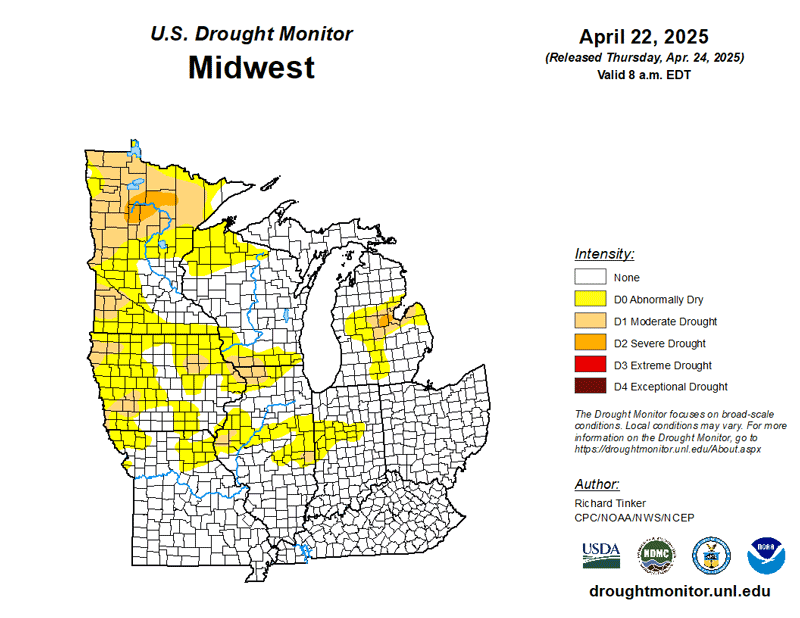
Below-Normal Precipitation Across Upper Midwest Since April 27
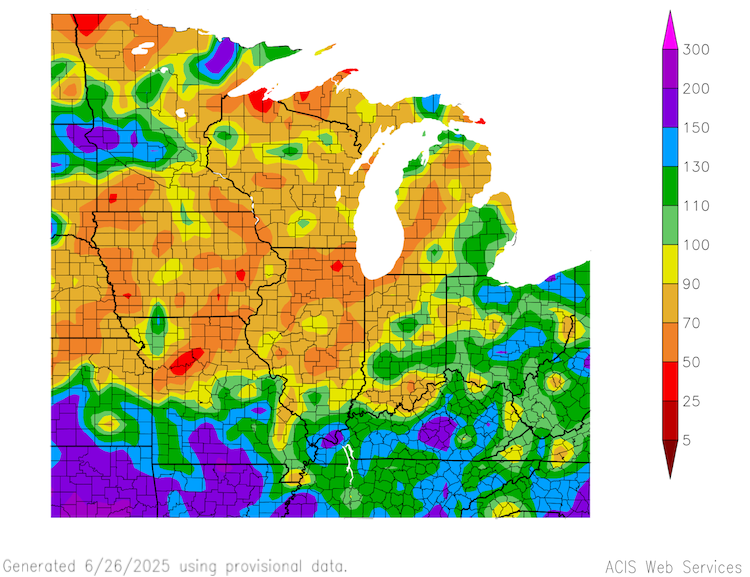
Dry Pockets of Below-Normal Soil Moisture Across the Midwest
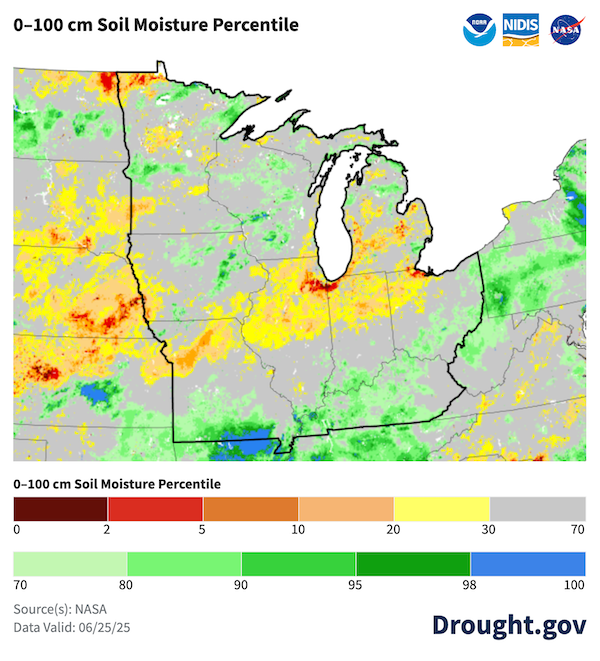
Outlooks and Potential Impacts in the Midwest
- The temperature outlook for July 2025 calls for increased chances of above-normal temperatures across the Upper Midwest, and equal chances for above-, near-, and below-normal temperatures elsewhere.
- July 2025 precipitation is predicted to be above-normal across Illinois, Indiana, Kentucky, Ohio, and southern Michigan, with below-normal precipitation forecast in western Missouri and Iowa.
- For portions of the Upper Midwest already in drought, conditions may persist or worsen for areas that receive above-normal temperatures and below-normal precipitation in July.
- For areas where drought persists or develops, potential impacts include inadequate moisture for crop growth, elevated risk for wildfire, and hydrological issues like low streamflow, lakes, and ponds.
- Northern Minnesota is expected to have above-normal significant wildland fire potential in July and August, according to the National Interagency Fire Center.
Above-Normal Temperatures Expected Across Upper Midwest in July

Precipitation Outlook Varies Across Midwest for July
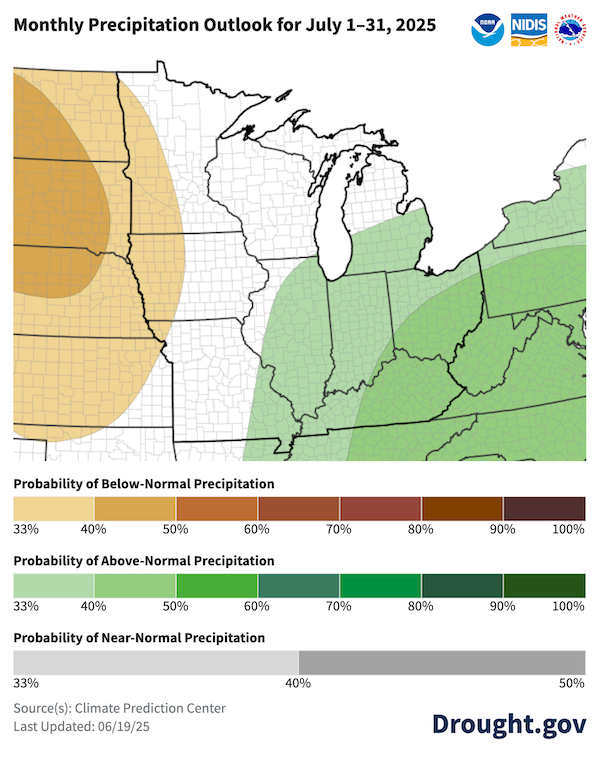
Resources
- Register for the Drought in the Midwest Webinar: Conditions, Outlooks, and Resources on August 7, 2025 at 2 p.m. CT. The webinar will cover current and developing drought conditions, drought impacts across sectors and industries, and outlook information for the coming months and seasons.
- More local information is available from the following resources:
- To report or view local drought impact information:
Prepared By
Molly Woloszyn
Cooperative Institute for Research in Environmental Sciences (CIRES) / NOAA National Integrated Drought Information System (NIDIS)
Cadence Oliver
William Lapenta Intern | NOAA/NIDIS
Melissa Widhalm
Midwestern Regional Climate Center / Purdue University
Denise Gutzmer
National Drought Mitigation Center
Dennis Todey
U.S. Department of Agriculture Midwest Climate Hub
Jeff Boyne & Andrea Thielke
NOAA National Weather Service Central Region
Jim Noel & Molly Peters
NOAA National Weather Service Ohio and North Central River Forecast Centers
Anna Wolverton
U.S. Army Corps of Engineers Mississippi Valley Division / NOAA National Weather Service
A special thank you to the state climate offices and National Weather Service offices in the Midwest region for providing local information on drought conditions and impacts included in the North Central webinar and in this Drought Status Update.
This Drought Status Update is issued in partnership between the National Oceanic and Atmospheric Administration (NOAA), U.S. Department of Agriculture (USDA), U.S. Army Corps of Engineers (USACE), and the National Drought Mitigation Center to communicate a potential area of concern for drought expansion and/or development within the Midwest region based on recent conditions and the upcoming forecast. NIDIS and its partners will issue future Drought Status Updates as conditions evolve.

